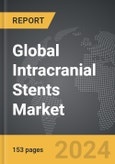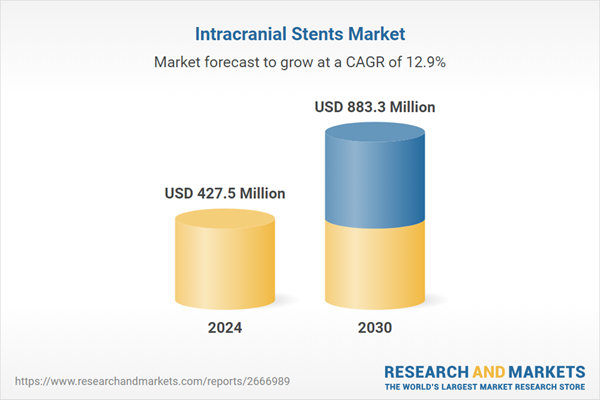The global market for Intracranial Stents was valued at US$427.5 Million in 2024 and is projected to reach US$883.3 Million by 2030, growing at a CAGR of 12.9% from 2024 to 2030. This comprehensive report provides an in-depth analysis of market trends, drivers, and forecasts, helping you make informed business decisions. The report includes the most recent global tariff developments and how they impact the Intracranial Stents market.
The potential of intracranial stents is being further explored through innovations such as drug-eluting stents (DES), which have been successful in coronary artery disease treatments by reducing in-stent stenosis. The application of DES in treating intracranial atherosclerosis holds promise, necessitating further studies to fully evaluate their benefits and risks in larger patient groups and over longer periods. Moreover, ongoing advancements in stenting technology and techniques continue to enhance the safety and effectiveness of these interventions in managing ICAS. The exploration of new stenting technologies and procedural advancements are crucial to improving outcomes and expanding the applicability of intracranial stents in clinical settings.
The growth in the intracranial stents market is driven by several key factors. The increasing prevalence of conditions like intracranial aneurysms and strokes catalyzes the demand for effective stenting solutions. Technological advancements in stent design and materials, coupled with a growing aging population at risk for cerebrovascular diseases, further stimulate this demand. Supportive government policies and rising healthcare expenditures globally also contribute to the adoption of advanced medical treatments like intracranial stenting. Additionally, the rising popularity of minimally invasive procedures, improved diagnostic techniques, and expansions in healthcare infrastructure support the broader use of intracranial stents. Partnerships between hospitals, academic institutions, and device manufacturers, along with favorable insurance and reimbursement policies, are crucial in driving innovation and facilitating the accessibility of these critical treatments. Together, these factors underscore the dynamic growth and vital role of intracranial stents in contemporary medical practice, addressing complex neurological conditions effectively.
Segments: Product Type (Self-Expanding Stents, Balloon Expanding Stents, Stent-Assisted Coil Embolization); Indication (Brain Aneurysm, Intracranial Stenosis); End-Use (Hospitals, Ambulatory Surgery Centers, Other End-Uses).
Geographic Regions/Countries: World; United States; Canada; Japan; China; Europe (France; Germany; Italy; United Kingdom; Spain; Russia; and Rest of Europe); Asia-Pacific (Australia; India; South Korea; and Rest of Asia-Pacific); Latin America (Argentina; Brazil; Mexico; and Rest of Latin America); Middle East (Iran; Israel; Saudi Arabia; United Arab Emirates; and Rest of Middle East); and Africa.
The analysts continuously track trade developments worldwide, drawing insights from leading global economists and over 200 industry and policy institutions, including think tanks, trade organizations, and national economic advisory bodies. This intelligence is integrated into forecasting models to provide timely, data-driven analysis of emerging risks and opportunities.
Intracranial Stents- Key Trends and Drivers Summarized
Intracranial stenting has become an essential treatment for intracranial atherosclerotic stenosis (ICAS), a major cause of stroke, particularly in Asian populations. Despite various treatment strategies including surgery and medication, endovascular treatments like stenting have gained prominence. However, comparative studies such as the Stenting and Aggressive Medical Management for Preventing Recurrent Stroke in Intracranial Stenosis (SAMMPRIS) trial suggest that while stenting is effective in certain scenarios, it does not universally outperform medical management. The trials indicate that stenting may be particularly beneficial for patients with specific types of strokes and those who have high recurrent stroke rates due to conditions like impaired collateral flow. The technology faces challenges, including regulatory restrictions on patient selection and the management of periprocedural risks such as unstable plaque and hyperperfusion, which are significant in determining the timing and success of stenting procedures.The potential of intracranial stents is being further explored through innovations such as drug-eluting stents (DES), which have been successful in coronary artery disease treatments by reducing in-stent stenosis. The application of DES in treating intracranial atherosclerosis holds promise, necessitating further studies to fully evaluate their benefits and risks in larger patient groups and over longer periods. Moreover, ongoing advancements in stenting technology and techniques continue to enhance the safety and effectiveness of these interventions in managing ICAS. The exploration of new stenting technologies and procedural advancements are crucial to improving outcomes and expanding the applicability of intracranial stents in clinical settings.
The growth in the intracranial stents market is driven by several key factors. The increasing prevalence of conditions like intracranial aneurysms and strokes catalyzes the demand for effective stenting solutions. Technological advancements in stent design and materials, coupled with a growing aging population at risk for cerebrovascular diseases, further stimulate this demand. Supportive government policies and rising healthcare expenditures globally also contribute to the adoption of advanced medical treatments like intracranial stenting. Additionally, the rising popularity of minimally invasive procedures, improved diagnostic techniques, and expansions in healthcare infrastructure support the broader use of intracranial stents. Partnerships between hospitals, academic institutions, and device manufacturers, along with favorable insurance and reimbursement policies, are crucial in driving innovation and facilitating the accessibility of these critical treatments. Together, these factors underscore the dynamic growth and vital role of intracranial stents in contemporary medical practice, addressing complex neurological conditions effectively.
Report Scope
The report analyzes the Intracranial Stents market, presented in terms of units. The analysis covers the key segments and geographic regions outlined below.Segments: Product Type (Self-Expanding Stents, Balloon Expanding Stents, Stent-Assisted Coil Embolization); Indication (Brain Aneurysm, Intracranial Stenosis); End-Use (Hospitals, Ambulatory Surgery Centers, Other End-Uses).
Geographic Regions/Countries: World; United States; Canada; Japan; China; Europe (France; Germany; Italy; United Kingdom; Spain; Russia; and Rest of Europe); Asia-Pacific (Australia; India; South Korea; and Rest of Asia-Pacific); Latin America (Argentina; Brazil; Mexico; and Rest of Latin America); Middle East (Iran; Israel; Saudi Arabia; United Arab Emirates; and Rest of Middle East); and Africa.
Key Insights:
- Market Growth: Understand the significant growth trajectory of the Self-Expanding Stents segment, which is expected to reach US$594.0 Million by 2030 with a CAGR of a 13.9%. The Balloon Expanding Stents segment is also set to grow at 11.8% CAGR over the analysis period.
- Regional Analysis: Gain insights into the U.S. market, valued at $113.8 Million in 2024, and China, forecasted to grow at an impressive 17.8% CAGR to reach $207.9 Million by 2030. Discover growth trends in other key regions, including Japan, Canada, Germany, and the Asia-Pacific.
Why You Should Buy This Report:
- Detailed Market Analysis: Access a thorough analysis of the Global Intracranial Stents Market, covering all major geographic regions and market segments.
- Competitive Insights: Get an overview of the competitive landscape, including the market presence of major players across different geographies.
- Future Trends and Drivers: Understand the key trends and drivers shaping the future of the Global Intracranial Stents Market.
- Actionable Insights: Benefit from actionable insights that can help you identify new revenue opportunities and make strategic business decisions.
Key Questions Answered:
- How is the Global Intracranial Stents Market expected to evolve by 2030?
- What are the main drivers and restraints affecting the market?
- Which market segments will grow the most over the forecast period?
- How will market shares for different regions and segments change by 2030?
- Who are the leading players in the market, and what are their prospects?
Report Features:
- Comprehensive Market Data: Independent analysis of annual sales and market forecasts in US$ Million from 2024 to 2030.
- In-Depth Regional Analysis: Detailed insights into key markets, including the U.S., China, Japan, Canada, Europe, Asia-Pacific, Latin America, Middle East, and Africa.
- Company Profiles: Coverage of players such as Boston Scientific Corporation, Cook Medical, Inc., Johnson & Johnson, Medtronic PLC, Penumbra, Inc. and more.
- Complimentary Updates: Receive free report updates for one year to keep you informed of the latest market developments.
Some of the 14 companies featured in this Intracranial Stents market report include:
- Boston Scientific Corporation
- Cook Medical, Inc.
- Johnson & Johnson
- Medtronic PLC
- Penumbra, Inc.
- Stryker Corporation
- Terumo Corporation
Tariff Impact Analysis: Key Insights for 2025
Global tariff negotiations across 180+ countries are reshaping supply chains, costs, and competitiveness. This report reflects the latest developments as of April 2025 and incorporates forward-looking insights into the market outlook.The analysts continuously track trade developments worldwide, drawing insights from leading global economists and over 200 industry and policy institutions, including think tanks, trade organizations, and national economic advisory bodies. This intelligence is integrated into forecasting models to provide timely, data-driven analysis of emerging risks and opportunities.
What’s Included in This Edition:
- Tariff-adjusted market forecasts by region and segment
- Analysis of cost and supply chain implications by sourcing and trade exposure
- Strategic insights into geographic shifts
Buyers receive a free July 2025 update with:
- Finalized tariff impacts and new trade agreement effects
- Updated projections reflecting global sourcing and cost shifts
- Expanded country-specific coverage across the industry
Table of Contents
I. METHODOLOGYII. EXECUTIVE SUMMARY2. FOCUS ON SELECT PLAYERSIII. MARKET ANALYSISCANADAITALYSPAINRUSSIAREST OF EUROPESOUTH KOREAREST OF ASIA-PACIFICARGENTINABRAZILMEXICOREST OF LATIN AMERICAIRANISRAELSAUDI ARABIAUNITED ARAB EMIRATESREST OF MIDDLE EASTIV. COMPETITION
1. MARKET OVERVIEW
3. MARKET TRENDS & DRIVERS
4. GLOBAL MARKET PERSPECTIVE
UNITED STATES
JAPAN
CHINA
EUROPE
FRANCE
GERMANY
UNITED KINGDOM
ASIA-PACIFIC
AUSTRALIA
INDIA
LATIN AMERICA
MIDDLE EAST
AFRICA
Companies Mentioned (Partial List)
A selection of companies mentioned in this report includes, but is not limited to:
- Boston Scientific Corporation
- Cook Medical, Inc.
- Johnson & Johnson
- Medtronic PLC
- Penumbra, Inc.
- Stryker Corporation
- Terumo Corporation
Table Information
| Report Attribute | Details |
|---|---|
| No. of Pages | 153 |
| Published | April 2025 |
| Forecast Period | 2024 - 2030 |
| Estimated Market Value ( USD | $ 427.5 Million |
| Forecasted Market Value ( USD | $ 883.3 Million |
| Compound Annual Growth Rate | 12.9% |
| Regions Covered | Global |









